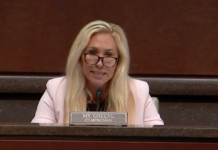
(GA Recorder) — Georgia GOP lawmakers released a proposed Congressional map Friday afternoon that questionably complies with a federal judge’s order to create a new majority Black congressional district west of metro Atlanta while maintaining the party’s current partisan balance and likely imperiling the seat of a prominent Black Democrat.
Lawmakers will take a first look at the plan Monday morning at a meeting of the House Redistricting Committee, but House Speaker Jon Burns, a Newington Republican, said he’s pleased with the new borders.
“This map meets the promise we made when this process began: it fully complies with the judge’s order while also following Georgia’s traditional redistricting principles,” he said. “We look forward to passing this fair redistricting plan.”
Sen. Shelly Echols, chair of the Senate Committee on Reappointment and Redistricting, released a statement that was less effusive.
“As we proceed with the 2023 Special Session, we have released the proposed plan for Georgia’s Congressional Districts,” she said. “We invite all members of the public to provide their comment where they see fit. The proposed maps are available on the Legislative and Congressional Reapportionment Office’s website, and written comments can be submitted by the public through the portal available on the Georgia General Assembly website.”
U.S. District Judge Steve Jones ordered the state Legislature to create new maps for the state House, Senate and U.S. Congress after finding their initial attempts in 2021 did not comply with the Voting Rights Act’s mandate to protect Black voters’ rights.
One of Jones’ remedies was the creation of a new majority Black Congressional district, and the map features a new 6th Congressional District including part of Atlanta, southern Fulton County and pieces of south Cobb, east Douglas and northern Fayette counties. That area is currently mostly part of the 13th District, represented by Democrat David Scott.
According to the map, the revised 6th District will be 50.18% Black. Black people tend to vote more for Democratic candidates.
But the map also contains nine out of 14 districts with white populations higher than 50%, the same as the challenged maps.
In data attached to the map proposal, there are four Black districts when counting people 18 and older who described themselves as Black alone or in part, the statistic Jones ruled the court will use: the 4th, 5th, 6th, and 13th, the same number as the current plan.
Democratic Congresswoman Lucy McBath said her 7th District seat will shift more than 20 points in favor of a Republican if the new map passes.
“Georgia Republicans have yet again attempted to subvert voters by changing the rules,” said campaign manager Jake Orvis in a statement. “We will look to the ruling from Judge Jones in the coming weeks before announcing further plans. Regardless, Congresswoman McBath refuses to let an extremist few in the state legislature determine when her time serving Georgians in Congress is done.”
McBath also saw her district, then the 6th, drawn to be less friendly to a Democrat. She decided to run in the neighboring 7th District, where she defeated Democratic incumbent Carolyn Bourdeaux in 2022.
Republican Congressman Rich McCormick was able to take advantage of the new lines to claim the 6th for the GOP, setting the state’s partisan balance at nine Republicans to five Democrats. That caused some Democrats to seethe, arguing that, since President Joe Biden and Senators Raphael Warnock and Jon Ossoff, all Democrats, had recently won statewide elections, the state’s Congressional delegation should be closer to 50-50.
That didn’t happen then, and it’s not likely to happen under the new map, either. McCormick’s district, which would be the 7th in the newly proposed map, would be more than 63% white in the new map, up from 29.5% white under the current map.







